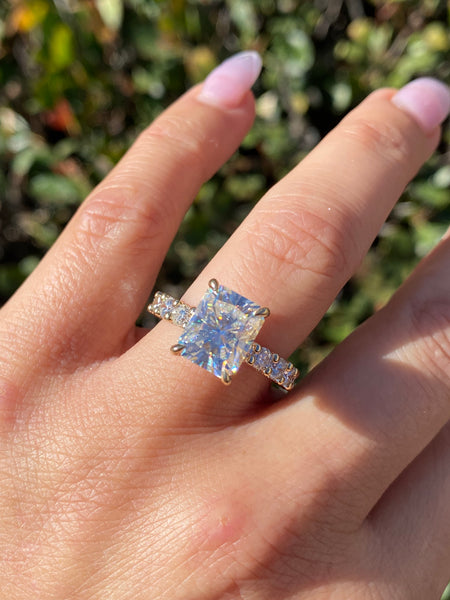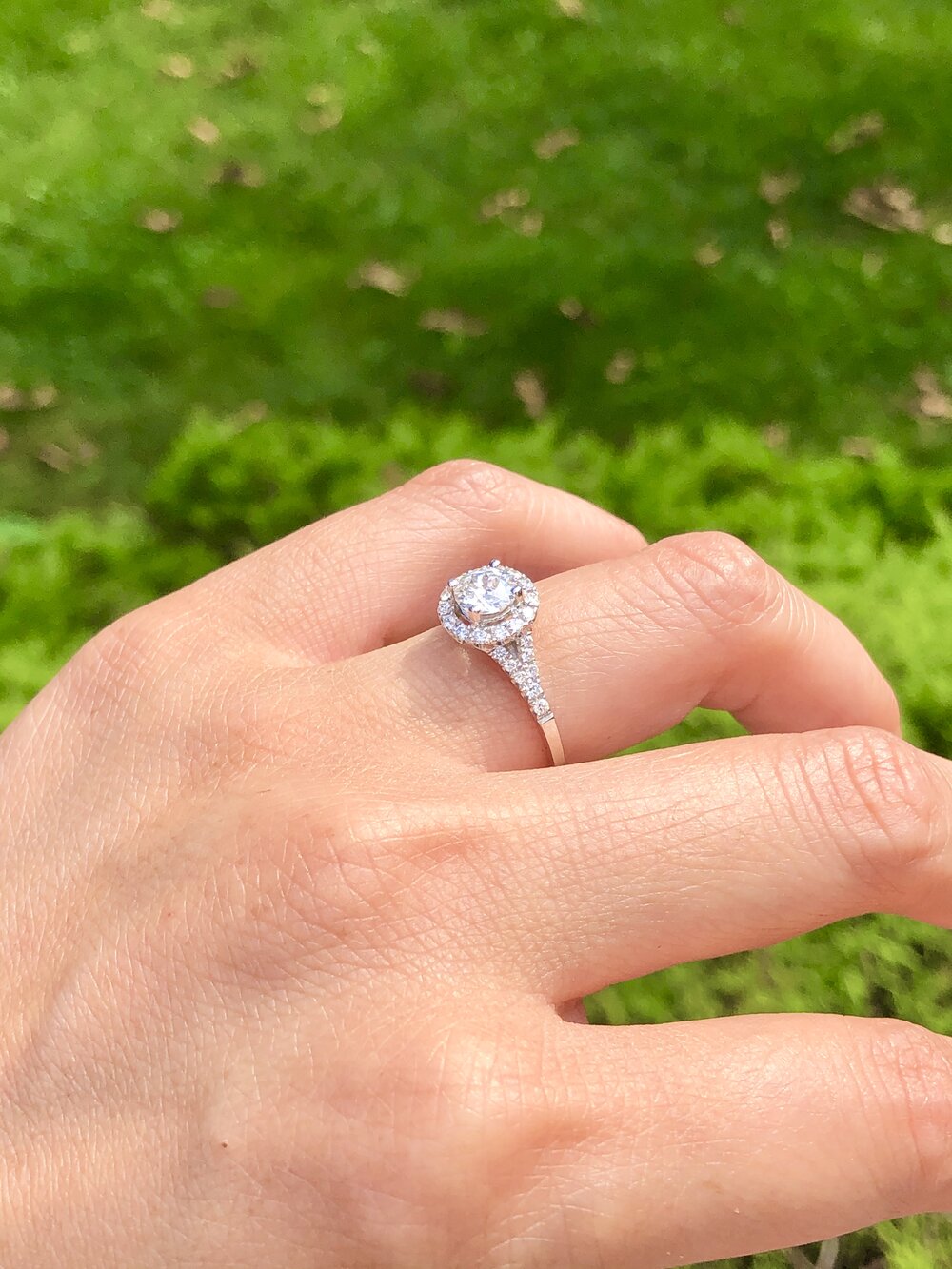What Gemologists Say About the Quality of lab grown diamond engagement rings
Wiki Article
Why Laboratory Grown Diamond Engagement Rings Are the Perfect Selection for Eco-Conscious Couples
Lab-grown Diamond involvement rings present an engaging option for pairs that prioritize sustainability. These rubies use a striking option to typical extracted rocks, substantially reducing ecological harm. They are produced using sophisticated methods that ensure both top quality and brilliance. As awareness of moral sourcing grows, lots of couples are reassessing their options. What effects does this shift have for the future of the Diamond industry?

The Environmental Effect of Conventional Diamond Mining
Although Diamond mining has long been commemorated for its appeal and stature, the environmental consequences of conventional mining methods are progressively concerning. The removal of rubies typically involves considerable land interruption, resulting in logging and habitat loss for numerous varieties. In addition, the process eats large quantities of water, which can deplete neighborhood sources and detrimentally affect surrounding neighborhoods. Hazardous chemicals made use of in mining procedures can infect close-by water resources, additionally threatening both human populaces and wild animals.In addition, the carbon impact associated with moving extracted diamonds includes in the overall environmental toll. The hefty equipment and devices required for mining operations add considerably to greenhouse gas emissions. As awareness of these concerns expands, many consumers are beginning to question the sustainability of typical Diamond sourcing. This change in perspective highlights the urgent need for more environmentally friendly alternatives, such as lab-grown diamonds, which promise to decrease the environmental influence while preserving the charm and worth of Diamond jewelry.
The Refine of Developing Lab-Grown Diamonds
Lab-grown diamonds are produced with 2 primary methods: High Pressure High Temperature Level (HPHT) and Chemical Vapor Deposition (CVD) The HPHT procedure simulates the natural problems under which diamonds form in the Earth's mantle. It entails subjecting carbon to severe pressure and temperature, causing the formation of carbon atoms into Diamond structures. On the other hand, the CVD method permits for the development of diamonds in a regulated atmosphere. This strategy utilizes a gas blend consisting of carbon, which is stimulated to form plasma, allowing carbon atoms to deposit onto a substrate and expand layer by layer right into Diamond crystals.Both approaches generate diamonds that are chemically and literally identical to all-natural rubies - lab grown diamond engagement rings. The choice of method typically depends on the preferred qualities and size of the last gem. This ingenious strategy to Diamond creation not just uses a lasting alternative but likewise enables better transparency in the sourcing of materials
Quality and Brilliance of Lab-Grown Diamonds
While lots of might assume that lab-grown diamonds differ in high quality from their natural counterparts, they in fact show similar brilliance and aesthetic allure. Lab-grown rubies are produced using innovative innovation that duplicates the natural problems under which diamonds develop, causing rocks that have similar physical and chemical properties. These diamonds achieve the exact same outstanding clarity and color grading as extracted rubies, making them identical to the naked eye.In regards to radiance, lab-grown rubies usually show exceptional light efficiency due to their precision-cut facets. The extensive high quality control during production assurances that these diamonds fulfill high criteria, improving their aesthetic appeal. Furthermore, they are offered in a variety of sizes and shapes, allowing pairs to discover the best ring to match their individual style. Eventually, lab-grown rubies provide an exquisite mix of elegance and high quality, making them an attractive selection for engagement rings.
Ethical Considerations in the Diamond Industry
As customers become progressively aware of the honest effects surrounding Diamond sourcing, the discussion around the Diamond sector has actually changed noticeably. Problems regarding dispute diamonds, typically referred to as "blood rubies," have actually triggered require higher openness and responsibility in mining practices. These rubies are extracted in war areas and marketed to fund armed problem, raising severe ethical concerns for consumers. In addition, the ecological impact of traditional Diamond mining has come under examination, with concerns such as habitat damage and water pollution regularly highlighted.In response, many have actually transformed to lab-grown rubies as a much more moral alternative. These rocks are created in regulated environments, eliminating the risks connected with mining. Subsequently, lab-grown diamonds interest consumers looking for to make liable choices that line up with their values. The expanding demand for ethical techniques proceeds to improve the Diamond sector, promoting gentle and lasting sourcing approaches.
Cost-Effectiveness of Lab-Grown Diamonds
Lab-grown rubies use an engaging alternative for customers looking for affordable engagement rings - lab grown diamond engagement rings. Priced significantly lower than their all-natural equivalents, they provide exceptional value for cash without sacrificing high quality or appearance. This affordability makes lab-grown rubies an attractive alternative for budget-conscious couplesReduced Price Factor
Lots of couples are finding that choosing lab-grown Diamond interaction rings can significantly lower their general expenses without sacrificing top quality or charm. These diamonds normally cost 30% to 50% less than their mined counterparts, making them an appealing choice for budget-conscious consumers. The rate advantage emerges from lower manufacturing prices and a more efficient supply chain, which eliminates the expenditures connected with mining. Therefore, couples can spend in larger stones or more detailed setups, boosting the general visual of their rings. great post to read This price not just enables for a much more tailored choice however additionally lines up with the values of eco-conscious couples who focus on sustainability while remaining financially smart. Lab-grown diamonds give an excellent blend of elegance and economic situation.Worth for Cash
The cost-effectiveness of lab-grown rubies extends past their first price, providing outstanding worth for cash. Unlike natural diamonds, lab-grown choices can be up to 40% cheaper while maintaining the same physical and chemical buildings. This cost allows pairs to purchase bigger or higher-quality stones without exceeding their spending plans. In addition, the resale worth of lab-grown rubies is slowly improving, making them a more feasible option for future economic considerations. Additionally, lab-grown rubies commonly feature reduced environmental and honest prices, giving couples with comfort. By selecting lab-grown rubies, eco-conscious couples not only save cash yet additionally add to lasting methods, enhancing their overall value proposal in the precious jewelry market.
Personalization Options for Lab-Grown Engagement Rings
Exactly how can couples ensure their involvement ring mirrors their distinct romance? Personalization choices for lab-grown Diamond engagement rings supply a perfect remedy. Pairs can pick from different Diamond shapes, consisting of round, princess, or oval, allowing them to choose a design that reverberates with their personal aesthetic.In addition, they can select the setting-- be it solitaire, halo, or vintage-inspired-- guaranteeing the ring enhances the Diamond's sparkle. Steel selections, such as white gold, yellow gold, or climbed gold, even more boost customization, satisfying specific tastes.
Pairs can incorporate significant inscriptions, including a sentimental touch that symbolizes their bond. With these extensive personalization choices, lab-grown Diamond engagement rings not only embody a pair's love however additionally mirror their worths, making them an excellent choice for eco-conscious partnerships. Inevitably, these rings come to be a true representation of their unique trip together.
Frequently Asked Concerns
How Do Lab-Grown Diamonds Contrast to All-natural Diamonds in Value?
Lab-grown rubies generally cost 20-40% much less than all-natural rubies, providing similar quality and appearance. Their reduced cost point makes them an enticing alternative, particularly for budget-conscious customers seeking lasting and moral options in precious jewelry.
Are Lab-Grown Diamonds Much More Resilient Than Natural Diamonds?
Lab-grown rubies have the exact same physical and chemical residential or commercial properties as all-natural diamonds, including resilience. Both kinds rack up an excellent 10 on the Mohs scale, making certain that lab-grown rubies are just as immune to scratching and damages.Can Lab-Grown Diamonds Be Resold Quickly?
Lab-grown diamonds can be resold, however their market demand differs compared to all-natural diamonds. While some purchasers why not try these out appreciate their moral origins, others may favor natural choices, potentially impacting resale value and convenience of purchase.What Are the Treatment Directions for Lab-Grown Diamonds?
Lab-grown rubies need routine like maintain their luster. Cleaning with moderate soap and warm water, using a soft brush, and staying clear of rough chemicals will help maintain their sparkle and stability for several years ahead.Exist Any Accreditations for Lab-Grown Diamonds?
Lab-grown diamonds can be licensed by credible companies such as the Gemological Institute of America (GIA) and the International Gemological Institute (IGI) These accreditations assure adherence, high quality, and authenticity to industry criteria for lab-created gemstones.Both techniques produce diamonds that are chemically and literally the same to all-natural rubies. Lab-grown diamonds are developed utilizing innovative innovation that reproduces the natural problems under which rubies create, resulting in click for more rocks that have similar physical and chemical buildings. Lab-grown diamonds typically cost 20-40% less than all-natural rubies, offering similar quality and appearance. Lab-grown diamonds have the very same physical and chemical residential properties as all-natural rubies, including durability. Lab-grown rubies can be re-selled, however their market demand varies compared to all-natural rubies.
Report this wiki page